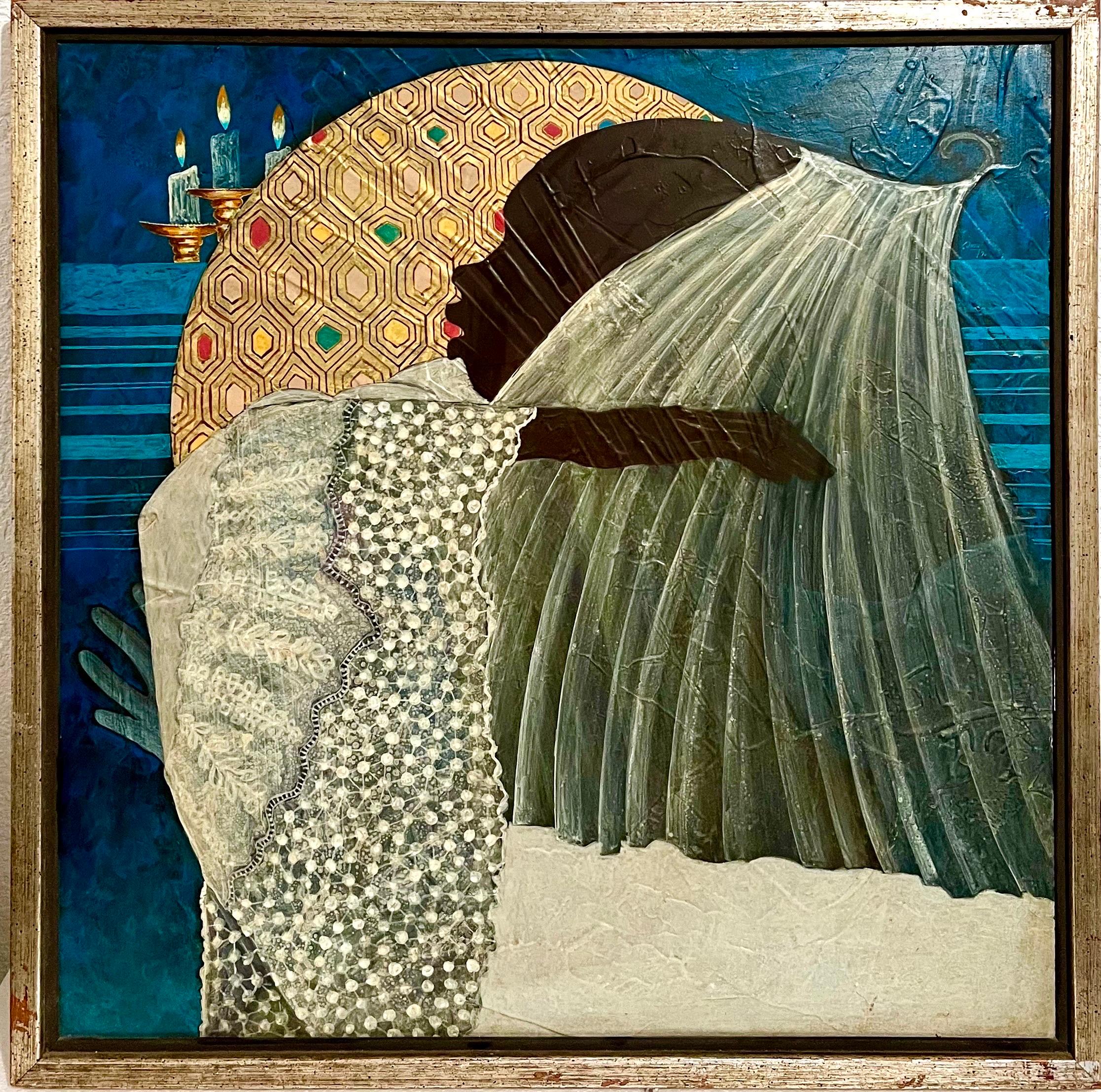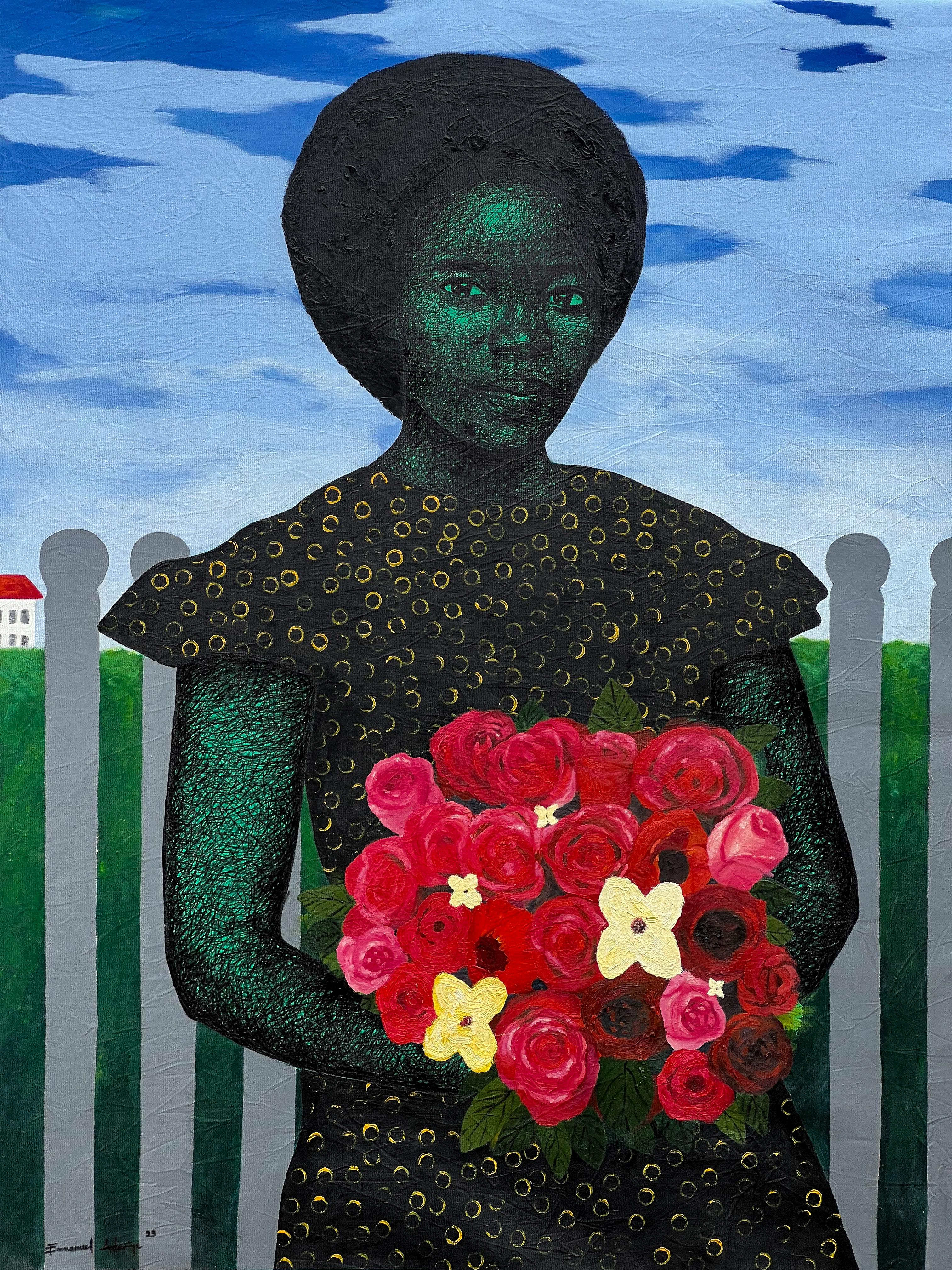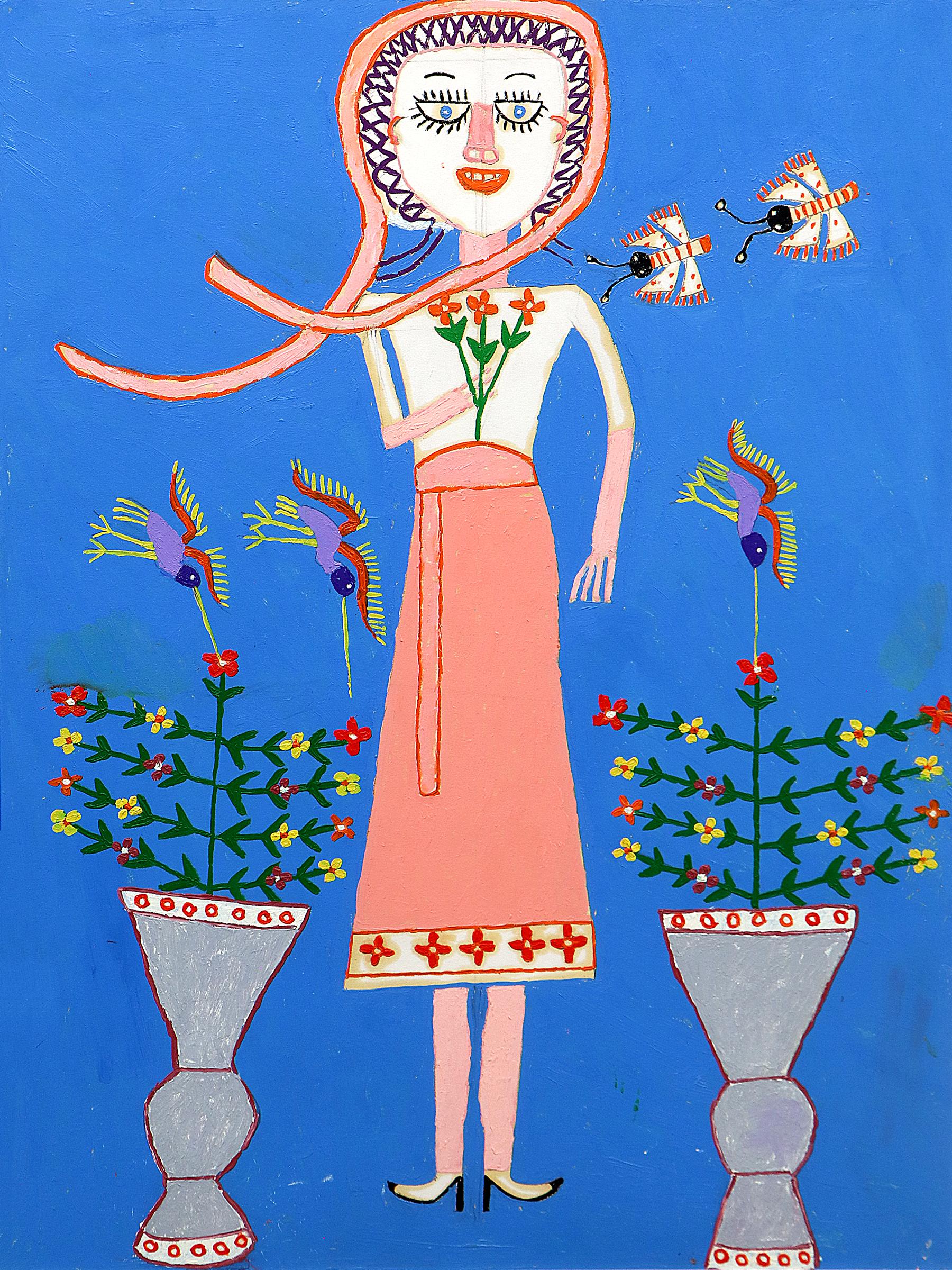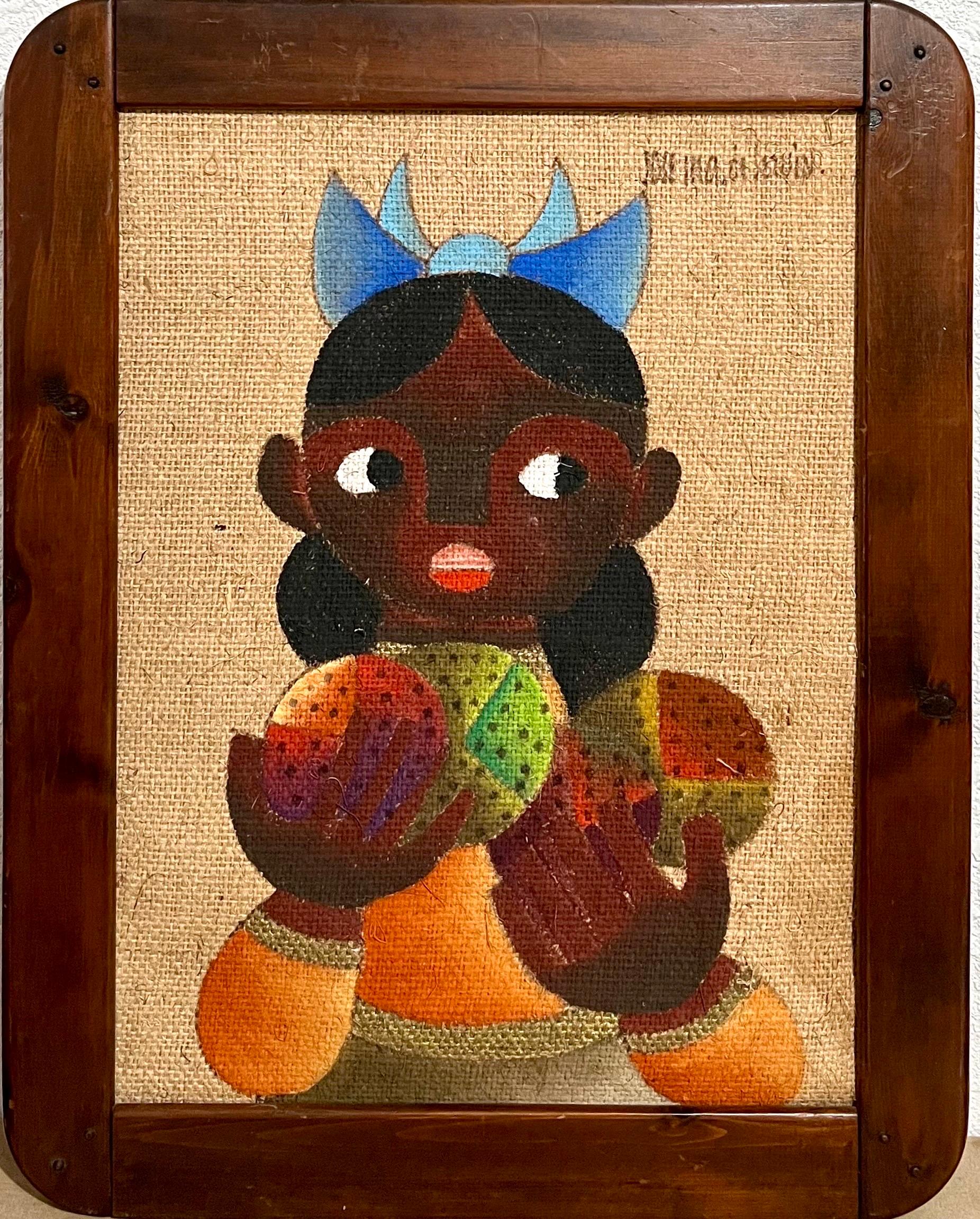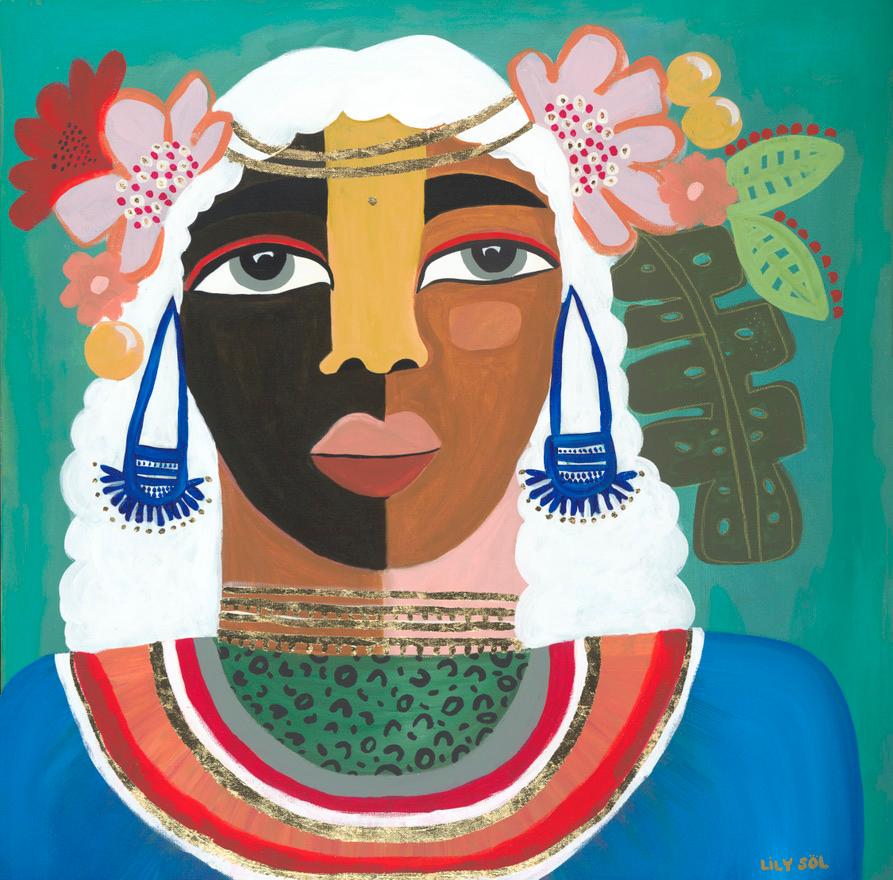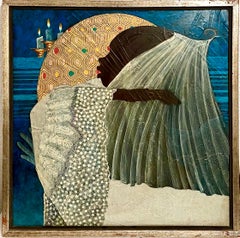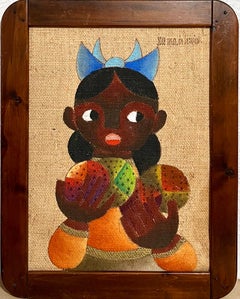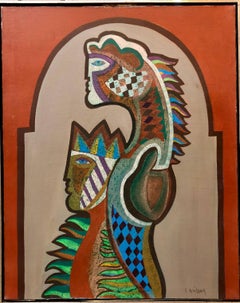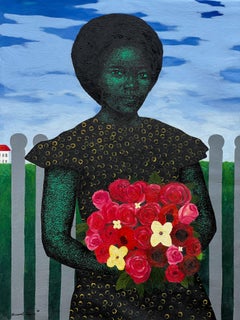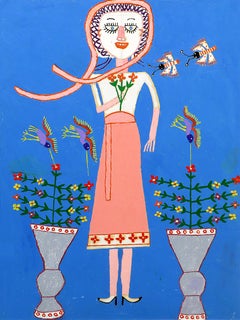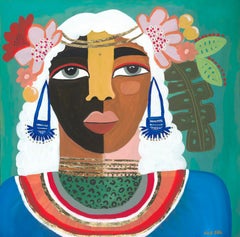Items Similar to Alabama Surreal Folk Art Oil Painting African American Woman, Flower Headdress
Want more images or videos?
Request additional images or videos from the seller
1 of 14
Alabama Surreal Folk Art Oil Painting African American Woman, Flower Headdress1960
1960
$2,800
£2,140.75
€2,465.71
CA$3,923.66
A$4,380.40
CHF 2,295.26
MX$53,620.34
NOK 29,149.84
SEK 27,484.60
DKK 18,401.85
About the Item
The painting is signed Sykes and dated 1960 lower right.
It has "Maltby Sykes, 1911- for Leon" written on the stretcher verso
It is a Surrealist Folk Art figure of an African woman oil painting on canvas
Attributed to Maltby Sykes (1911-1992)
Provenance: This painting was originally purchased from the estate of Philip Bibel (San Francisco, California), received from his brother Leon Bibel. Maltby Sykes was a versatile artist. If you review Sykes's early work, you will find a lot of prints, portraits, surreal and abstract expressionist compositions. By the 1970's, Sykes style had totally changed. He was producing more non-objective, abstract work, sometimes bordering on minimalism. The surreal use of lighting, combined with representational outlines of floral abstract designs, makes this painting very interesting. I have not been able to find too many other examples of Sykes's oil painting from 1960-1965. Leon Bibel was another modernist artist, who gave this painting to his brother Phillip.
William Paul Maltby Sykes was born in Aberdeen, Mississippi in 1911, but was raised in Birmingham, Alabama.
A painter, print maker, and graphic artist, he was a long-time professor of art at the Polytechnic Institute in Auburn, Alabama, He studied at the Art Students League in New York City with John Sloan, Wayman Adams and in mexico with Diego Rivera with whom he later worked on a mural. In France on the GI bill he studied with Fernand Leger and Stanley William Hayter, and then on a subsequent trip with Andre L'hote. A Southern artist, He was a member of the Alabama Art League, Alabama Watercolor Society, and the Southeastern Art Association. Exhibition venues include many entries in Alabama, Mississippi and Louisiana as well as the Museum of Modern Art in New York, and the Pennsylvania Academy in Philadelphia. Member: Salmagundi Club. Exhibited: National Academy of Design; American Watercolor Society; Pennsylvania Academy of Fine Arts; Metropolitan Museum of Art; Modern Museum of Art.
Author: The Multi Metal Lithography Process
- Attributed to:Maltby Sykes (1911 - 1992)
- Creation Year:1960
- Dimensions:Height: 31 in (78.74 cm)Width: 24.5 in (62.23 cm)
- Medium:
- Movement & Style:
- Period:
- Condition:stretcher mark, minor wear and crazing, toning to varnish. please see photos. frame is loose.
- Gallery Location:Surfside, FL
- Reference Number:1stDibs: LU38215781512
About the Seller
4.9
Platinum Seller
Premium sellers with a 4.7+ rating and 24-hour response times
Established in 1995
1stDibs seller since 2014
1,786 sales on 1stDibs
Typical response time: <1 hour
- ShippingRetrieving quote...Shipping from: Surfside, FL
- Return Policy
Authenticity Guarantee
In the unlikely event there’s an issue with an item’s authenticity, contact us within 1 year for a full refund. DetailsMoney-Back Guarantee
If your item is not as described, is damaged in transit, or does not arrive, contact us within 7 days for a full refund. Details24-Hour Cancellation
You have a 24-hour grace period in which to reconsider your purchase, with no questions asked.Vetted Professional Sellers
Our world-class sellers must adhere to strict standards for service and quality, maintaining the integrity of our listings.Price-Match Guarantee
If you find that a seller listed the same item for a lower price elsewhere, we’ll match it.Trusted Global Delivery
Our best-in-class carrier network provides specialized shipping options worldwide, including custom delivery.More From This Seller
View All1970 Haitian Mod Gold Painting Portrait of African American Woman Emilcar Simil
By Emilcar Similien (SIMIL)
Located in Surfside, FL
Feu de Joie
1970
hand signed and dated.
Measurements: 25.75 X 25.75 Framed. Image is 23.75 X 23.75
Emilcar Similien, known as Simil was born in 1944 in St. Marc. He finished elementary school in St. Marc and high school in Port-au-Prince. From 1965 until 1971 he studied at the Academy of Beaux-Arts in Port-au-Prince, where he took courses in painting, sculpture, and art history. Simil uses his images of women only as means for displaying patterns, color, and the sparkle of gold jewelry on black skin. He paints with acrylics on Masonite of any size. His surfaces are smooth and polished. Simil delights in beauty, elegance, and grace. This is done in a silhouette style reminiscent of Kara Walker.
Emilcar Simil (Similcar) is known for Acrylic painting in high colors of black skinned female figures. He is of the generation of Haitian artists that include Bernard Sejourne, Prospere Pierre-Louis, Levoy Exil, Louisiane Saint Fleurant, Henri Calixte, Paul Dieuseul, Laurent Casimir, Frantz Zephirin, Denis Smith, Philton Latortue, Philome Obin, Préfète Duffaut, Fernand Pierre...
Category
1970s Modern Portrait Paintings
Materials
Canvas, Acrylic Polymer, Acrylic
Folk Art Mexican Girl Oil Painting on Burlap Charming Naive African American Art
By Jose Maria de Servin
Located in Surfside, FL
Framed 29 X 23
Image 18 X 24
The sweetness that characterizes the work of Mexican painter Jose Maria de Servin (1917-83) is a melancholy and placid one. While he worked in the most modern of styles, he adapted it to an anecdotal folk-art approach distinctly his own.
When he was an infant, de Servin's family moved with him to Guadalajara. A city of history and culture, Guadalajara had a thriving artistic community with strong connections to Europe. His brothers Antonio and Miguel became artists as well, and in later years they worked collaboratively. As a teenager, de Servin studied at one of Mexico's Schools of Open-Air Painting, free art-teaching institutions sponsored by the government.
Later de Servin became a pupil of the painter Chucho Reyes, known for his improvisational watercolor variations on traditional Mexican themes. This interest in imagery particular to Mexico would be of great significance to de Servin. De Servin also studied under the more traditional painter Jose Vizcarra. In the early 1930s de Servin joined the Pintores Jovenes de Jalisco, or Young Painters of Jalisco.
An influence of critical importance to de Servin was Pablo Picasso. One of the originators of Cubism, the Spanish painter soon departed from its quasi-scientific and optical basis to create lively and humorous geometrical abstractions. It was this Cubism, personal and decorative, that de Servin adopted. His earliest Cubist works mimic Picasso, while during the second stage of his career, his works become smooth and polished, with an emphasis on gentle surface textures.
After these cautious years, however, a rough boldness enters along with dominating colors of earth and sand. Modernists like de Servin were interested in exploring what they considered primitive artmaking styles. The adoption of a native manner and native themes is in keeping with Modernist tenets, as is the use of nontraditional materials. De Servin's portraits of peasants, large-eyed and simply rendered, recall children's drawings. The rough burlap ground contrasts with the playful imagery and delicate range of color. The figures, all children or child-like adults, are all curves and simple shapes arranged harmoniously. De Servin's cubism is free from grotesquerie as it celebrates the simplicity of its subjects.
De Servin worked with the social-realist Jose Orozco on several large mural commissions in Guadalajara, including one at the Legislative Palace. While their styles were dissimilar, both made use of Mexican imagery to glorify the common people. A sought-after muralist in his own right, de Servin brought the rich colors and endearing characters of his panels to his larger-scale work.
For 15 years, de Servin taught summer art classes at the University of Arizona. His career was marked by many one-man shows, both in North America and Europe. In recent years, his striking style has attracted increased notice from critics and the public.
His style is a unique conglomerate of tradition, history, legends, heroes, old customs and folklore. It is a self-standing style, recognizable, cheerful, whimsical and a happy creation. Naïve art is any form of visual art that is created by a person who lacks the formal education and training that a professional artist undergoes (in anatomy, art history, technique, perspective, ways of seeing). Unlike folk art, naïve art does not necessarily evince a distinct cultural context or tradition. Naïve art is recognized, and often imitated, for its childlike simplicity and frankness. Paintings of this kind typically have a flat rendering style with a rudimentary expression of perspective.
One particularly influential painter of "naïve art" was Henri Rousseau (1844–1910), a French Post-Impressionist who was discovered by Pablo Picasso. Naïve art is often seen as outsider art that is by someone without formal (or little) training or degree. While this was true before the twentieth century, there are now academies for naïve art. Naïve art is now a fully recognized art genre, represented in art galleries worldwide.
Museums devoted to naïve art now exist in Kecskemét, Hungary; Riga, Latvia; Jaen, Spain; Rio de Janeiro, Brasil; Vicq France and Paris. "Primitive art" is another term often applied to art by those without formal training, but is historically more often applied to work from certain cultures that have been judged socially or technologically "primitive" by Western academia, such as Native American, sub saharan African or Pacific Island art (see Tribal art). This is distinguished from the self-conscious, "primitive" inspired movement primitivism. Another term related to (but not completely synonymous with) naïve art is folk art. There also exist the terms "naïvism" and "primitivism" which are usually applied to professional painters working in the style of naïve art (like Paul Gauguin, Mikhail Larionov, Paul Klee).
At all events, naive art can be regarded as having occupied an "official" position in the annals of twentieth-century art since - at the very latest - the publication of the Der Blaue Reiter, an almanac in 1912. Wassily Kandinsky and Franz Marc, who brought out the almanac, presented 6 reproductions of paintings by le Douanier' Rousseau (Henri Rousseau), comparing them with other pictorial examples. However, most experts agree that the year that naive art was "discovered" was 1885, when the painter Paul Signac became aware of the talents of Henri Rousseau and set about organizing exhibitions of his work in a number of prestigious galleries. The Earth Group (Grupa Zemlja) were Croatian artists, architects and intellectuals active in Zagreb from 1929 to 1935. The group included the painters Krsto Hegedušić, Edo Kovačević, Omer Mujadžić, Kamilo Ružička, Ivan Tabaković, and Oton Postružnik, the sculptors Antun Augustinčić, Frano Kršinić, and the architect Drago Ibler. A term applied to Yugoslav (Croatian) naive painters working in or around the village of Hlebine, near the Hungarian border, from about 1930. Some of the best known naive artists are Dragan Gaži, Ivan Generalić, Josip Generalić, Krsto Hegedušić, Mijo Kovačić, Ivan Lacković-Croata, Franjo Mraz, Ivan Večenaj and Mirko Virius. Camille Bombois (1883–1970) Ferdinand Cheval, known as 'le facteur Cheval' (1836–1924) Henry Darger (1892–1973) L. S. Lowry (1887–1976) Grandma Moses, Anna Mary Robertson (1860–1961) Nikifor (1895–1968) Poland, Horace Pippin (1888–1946) Jon Serl (1894-1993) United States Alfred Wallis (1855–1942) Scottie Wilson (1890–1972) Gesner Abelard...
Category
Mid-20th Century Folk Art Figurative Paintings
Materials
Burlap, Oil
Israeli Folk Art Bright Colorful Naive Floral Painting, Mod Flowers in Vase
By Menia Litvak
Located in Surfside, FL
A fantastic vase of bold colorful flowers. signed and dated in Hebrew and English, Jerusalem 1989.
Litvak's life as an artist started in 1976 when he left Kishinev (Bessarabia) for Israel...
Category
20th Century Folk Art Figurative Paintings
Materials
Canvas, Oil, Acrylic
Surrealist Woman Oil painting French-Moroccan Israeli Bezalel School Painter
By Simon Avissar
Located in Surfside, FL
Two Women. Colorful Surrealist Portrait
Genre: Surrealism
Subject: woman
Medium: Oil
Surface: Canvas
Country: Israel
Simon Avissar, painter, born 1948, Morocco. Moved to U.S.A. Wo...
Category
20th Century Surrealist Figurative Paintings
Materials
Canvas, Oil
Expressionist African American Woman Portrait German Brazilian Harry Elsas
Located in Surfside, FL
Framed 20.5 x 18 image 14.5 x 12
Heinz Hugo Erich Elsas, (German-Brazilian 1925-1994) later known as Harry Elsas. Muralist, writer, designer best known as a painter.
Born in 1925 in Stuttgart, Germany, 1n 1936 At the age of 14 he moved with his family to Sao Paulo, Brazil fleeing from World War II and of the persecution of the Jews. A self taught artist he was influenced by the Flemish artists, his work reveals remarkable influence of Brueghel and Hieronymus Bosch. He worked in the workshop of Portinari, participating in the Tiradentes mural. His work went through a post-Expressionist phase, culminating in the adoption of cubism and is characterized by the habit of creating a three-dimensional structure before painting a picture. In 1945, he was working with Lasar Segall...
Category
20th Century Expressionist Figurative Paintings
Materials
Oil, Board
Italian Modernist Surrealist Lady With a Hat Oil Painting, Signora dal Cappello
By Lazzaro Donati
Located in Surfside, FL
Lazzaro Donati (Italian, 1926-1977), "Signora dal Cappello," oil on panel, signed lower left, signed, titled and dated verso, overall (with frame): 22.5"h x 24.5"w
Lazzaro Donati wa...
Category
1960s Surrealist Figurative Paintings
Materials
Oil, Panel
You May Also Like
Women with Flowers, Folk Art Acrylic Painting by Ernani Silva
Located in Long Island City, NY
Ernani Silva, Brazilian - Women with Flowers, Medium: Acrylic, Collage and Enamel on board, signed in marker, Size: 9.25 x 27.5 in. (23.5 x 69.85 cm)
Category
1990s Folk Art Figurative Paintings
Materials
Enamel
Virtuous Woman -21st Century, Contemporary, Figurative, Africa Woman with Flower
Located in Ibadan, Oyo
Shipping Procedure
Ships in a well-protected tube from Nigeria
This work is unique, not a print or other type of copy.
Accompanied by a Certificate of Authenticity.
Category
21st Century and Contemporary Expressionist Figurative Paintings
Materials
Canvas, Acrylic, Ink, Oil
Original Naïve Folk Art Oil Painting by Martin Saldaña – Whimsical Girl, Flowers
By Martin Saldana
Located in Denver, CO
This enchanting original oil painting, Pinky, is a beautiful example of whimsical Naïve folk art by the artist Martin Saldaña. The artwork features a charming portrait of a young gir...
Category
1950s Folk Art Figurative Paintings
Materials
Oil
"Wisdom" Contemporary portrait of black woman with white hair and floral crown.
Located in Edgartown, MA
Lily Sol’s current work “Flower Goddess” is a symbol of blooming into her true self and honoring the divine femine energy within all of us. Through her paintings she is able to celebrate the fierce women in her life and shine light on the diverse and unique beauty of cultures around the world. She loves exploring different mediums in her art journal, playing with collage, acrylic paints, watercolors, and pressed blooms. While painting she tries to stay in an intuitive mindset and allow her works to transform naturally—always seeking the harmony between staying loose yet in control, yin & yang of life. Bright colors, a playlist she can dance...
Category
2010s Abstract Paintings
Materials
Canvas, Oil
"Colors of Courage" Woman wearing floral headdress and colorful jewelry
By Janice Frame
Located in Edgartown, MA
"As an African-American artist in today’s world, I embody the vast differences found in our collective backgrounds. I view them as cultural assets. We are always self discovering an...
Category
2010s Contemporary Mixed Media
Materials
Board
My Imperfection Gaze - 21st Century, Contemporary, Surrealism, African Woman
Located in Ibadan, Oyo
A portrait can tell a story, my artistic pieces highlight the exploration of the complexity of human identity, space and existence. My imagery embodies the unconventional expression ...
Category
21st Century and Contemporary Surrealist Figurative Paintings
Materials
Glitter, Acrylic
$1,560 Sale Price
20% Off
More Ways To Browse
African Metal Art
William Stanley Hayter
John Andre
L Stanley
Paul Stanley
Oil Paintings Mississippi
1960s Surreal Art
Black Southern Folk Art
Paul Sloan
Philip Adams
John Maltby
Diego Rivera Print New York Graphic Society
Maltby Sykes
Saint Jerome
Venice Carnival
Antique Monte Carlo
Antique Paintings Peter Paul Rubens
Bruce Little
